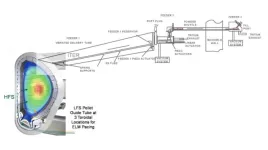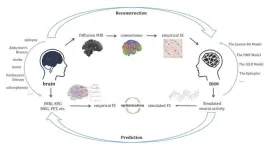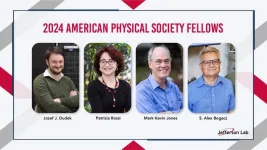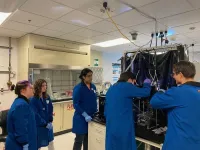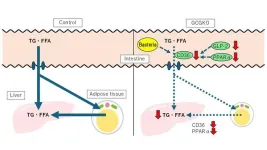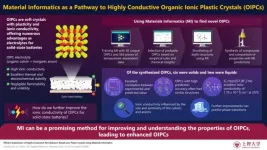(Press-News.org) Fusion researchers are increasingly turning to the element tungsten when looking for an ideal material for components that will directly face the plasma inside fusion reactors known as tokamaks and stellarators. But under the intense heat of fusion plasma, tungsten atoms from the wall can sputter off and enter the plasma. Too much tungsten in the plasma would substantially cool it, which would make sustaining fusion reactions very challenging. Now, researchers at the U.S. Department of Energy’s Princeton Plasma Physics Laboratory (PPPL) have experimental results suggesting that sprinkling boron powder into the tokamak could solve the problem. Boron partly shields the reactor wall from the plasma and prevents atoms from the wall from getting into the plasma. A new computer modeling framework, also led by PPPL researchers, shows the powder may only need to be sprinkled from one location. The experimental results and computer modeling framework will be presented this week at the 66th Annual Meeting of the American Physical Society Division of Plasma Physics in Atlanta.
Joseph Snipes, deputy head for Tokamak Experimental Science, is optimistic about the solid boron injection system based on experiments that demonstrated reduced tungsten sputtering after a solid boron injection. The experiments were conducted in three tungsten-walled tokamaks worldwide: one in Germany, one in China, and one in the U.S.
“The boron is sprinkled into the tokamak plasma as a powder, like from a saltshaker, which is ionized at the plasma’s edge and then deposited on the tokamak’s inner walls and the exhaust region,” he said. “Once coated with a thin layer of boron, it will stop the tungsten from getting into the plasma and radiating away the plasma energy.”
Snipes and his colleagues are working on the boron injection system with the ultimate goal of potentially using it in the ITER Organization’s reactor-scale tokamak. The injection system is well suited to the task, as it can add boron while the machine is operating. It can also precisely control and limit the amount of boron injected. The deposited boron layers retain the radioactive element tritium, which must be minimized in the ITER tokamak to comply with nuclear safety. Scientists and engineers from ITER and the Oak Ridge National Laboratory also collaborated on this project.
Florian Effenberg, a staff research physicist at PPPL, led a separate project to create a computer modeling framework for the boron injection system in the DIII-D tokamak. The framework suggests that sprinkling the boron powder from just one location may provide a sufficiently uniform distribution of boron across the reactor components considered in the simulation domain.
“We’ve developed a new way to understand how injected boron material behaves in a fusion plasma and how it interacts with the walls of fusion reactors to keep them in good condition while they are operating,” said Effenberg.
The researchers’ approach combines three different computer models to create a new framework and workflow. “One model simulates the behavior of the plasma, another shows how the boron powder particles move and evaporate in the plasma, and the third examines how the boron particles interact with the tokamak walls, including how they stick, wear away and mix with other materials,” Effenberg said.
“These insights are crucial for optimizing boron injection strategies to achieve effective and uniform wall conditioning in ITER and other fusion reactors,” Effenberg said.
While the modeling framework looked at DIII-D, a tokamak operated by General Atomics in San Diego, the next phase of this research involves scaling the modeling framework to ITER. While DIII-D’s walls are made of carbon, ITER plans to have tungsten walls, so it will be important to research any differences in how the boron protects the walls.
The following researchers also contributed to the work described by Snipes: Larry Robert Baylor, Alessandro Bortolon, Florian Effenberg, Erik Gilson, Alberto Loarte, Robert Lunsford, Rajesh Maingi, Steve Meitner, Federico Nespoli, So Maruyama, Alexander Nagy, Zhen Sun, Jeff Ulreich, Tom Wauters. Funding for this work was provided by the ITER Organization.
Klaus Schmid, Federico Nespoli and Yühe Feng worked on the modeling framework described by Effenberg in this release. Alessandro Bortolon, Jeremy Lore, Tyler Abrams, Brian Grierson, Rajesh Maingi and Dmitry Rudakov contributed to the application of that modeling framework. The work was completed with funding from DE-AC02-09CH11466, DE-FC02-04ER54698 and DE-AC05-00OR22725.
END
Stopping off-the-wall behavior in fusion reactors
Boron could help the tungsten wall inside a tokamak keep its atoms to itself
2024-10-07
ELSE PRESS RELEASES FROM THIS DATE:
Real-time cancer diagnostics and therapy through theranostics
2024-10-07
Developing new cancer treatment tools, using imaging techniques such as PET-CT and MRI, and new radiopharmaceuticals for next-generation personalized therapies (“Theranostics”) to target cancer first at the “diagnosis” phase and then at the “therapy” phase, using the same biological targets (“see to treat”). Additionally, the project aims to develop and implement AI-based tools for data sharing among research and hospitals, supporting clinical decisions and predicting individual patient treatment response and outcome.
This is the main ...
Researchers confront new US and global challenges in vaccinations of adults
2024-10-07
Vaccines to prevent common and serious infectious diseases have had a greater impact on improving human health than any other medical advance of the 20th century, surpassing even sanitation and potable water. From the global eradication of smallpox in 1980 to the unprecedented development of effective and safe mRNA vaccines for COVID-19, vaccinations have played crucial roles in preventing millions of premature deaths and hospitalizations in adults and children.
These monumental efforts have involved coordinated local, regional, national and international organizations and dedicated clinical ...
NCSA building stronger connections among observatories, astronomers
2024-10-07
With hundreds of observatories scattered throughout the world, there has never been a better time for astronomers to observe the infinite universe that lies beyond Earth. At any moment in time, a telescope pointed at the night sky can observe new transient phenomena, such as supernovae that brighten rapidly and then fade away over days to months, releasing massive amounts of energy in the process. These events are rare in any single galaxy and each gives researchers more insight into the dynamic time-domain sky.
But what if these observatories could work even closer together to view these important astronomical events?
The National ...
Latest advances in brain network models for medical applications: A comprehensive review highlights future potential
2024-10-07
A research team from the International Research Institute for Artificial Intelligence at Harbin Institute of Technology, Shenzhen, has recently published a comprehensive review in the journal Health Data Science on the application of Brain Network Models (BNMs) in the medical field. This study summarizes recent advances and challenges in using BNMs to simulate brain activities, understand neuropathological mechanisms, evaluate therapeutic effects, and predict disease progression.
Brain Network Models ...
Jefferson Lab physicists named APS Fellows
2024-10-07
NEWPORT NEWS, VA – Four physicists affiliated with the U.S. Department of Energy’s Thomas Jefferson National Accelerator Facility have been selected by their peers for the distinct honor of Fellow of the American Physical Society.
“Our staff power the science and innovation that are continuing to move the discipline of physics and this laboratory into the future,” said Jefferson Lab Director Kim Sawyer. “We’re very proud that the accomplishments and contributions of these four Jefferson Lab staff members to the field of physics are being recognized by their peers with this honor.”
According to the APS, fellows have made ...
Bias found when drug manufacturers fund clinical trials
2024-10-07
COLUMBUS, Ohio – Psychiatric drugs are reported to be about 50% more effective in clinical trials funded by the drug’s manufacturer than when trials of the same drug are sponsored by other groups, new research shows.
While many studies have found more favorable results for drugs in clinical trials funded by their manufacturers, these studies normally just compare a set of manufacturer-funded studies with a set of studies funded in other ways, said Tamar Oostrom, assistant professor of economics at The Ohio State University, who conducted this new research.
This ...
The University of Texas at San Antonio is advancing space exploration as the lead of a multimillion-dollar DOE project
2024-10-07
UTSA was selected by the U.S. Department of Energy’s (DOE) Office of Nuclear Energy (NE) to lead a multimillion-dollar project that will stimulate nuclear energy research at UTSA, leverage novel experimental data to bolster computational efforts at the university, and provide professional training to prepare undergraduate and graduate students for careers in nuclear energy science. UTSA researchers will collaborate with a leading nuclear energy laboratory as well as across academic institutions.
The award is part of the DOE’s Nuclear Energy University Program’s Integrated Research Projects (IRPs). These projects aim to provide research and development solutions ...
Gut hormones could hold the key to fighting fatty liver disease
2024-10-07
The accumulation of fats in the liver is driven by high-fat diets and obesity, and is becoming an increasingly prevalent global health concern. Characterized by excessive fat accumulation in the liver, this condition poses significant risks for various metabolic disorders. While much of the existing research has focused on fat metabolism within the liver itself, emerging findings emphasize the critical role of the gut in this complex process. Proglucagon-derived peptides (PGDPs), including glucagon, GLP-1, and GLP-2, are known to be the key hormones that regulate lipid metabolism in the liver. Derived from the same precursor—proglucagon, previous studies ...
Material informatics for the development of high-performance solid electrolytes in rechargeable batteries
2024-10-07
The surge in the adoption of renewable energy, coupled with the rapid growth of the electric vehicle market in recent years has significantly increased the demand for high-performance, all-solid-state batteries. Compared to conventional liquid electrolyte-based batteries, solid-state batteries offer higher energy density, improved safety, longer lifespan, and reliable operation over a wide temperature range. However, there are still challenges to their widespread applications, including low ionic conductivity, high interfacial resistance, and the presence of particle-particle interfaces in the electrolyte, which leads to increased resistance and lower energy density.
Notably, ...
Decoding bacterial genomes using single-cell genomics
2024-10-07
The human microbiome plays a critical role in our health, influencing everything from disease development to treatment responses. This connection has captured the attention of scientists worldwide, eager to unlock its secrets. While traditional metagenomics has provided valuable insights, it falls short in resolving microbial diversity at the strain level and accurately profiling genes involved in antibiotic resistance. These limitations highlight the need for more advanced approaches.
To address this, a team of researchers led by Associate Professor Masahito Hosokawa, from Waseda University, in collaboration with bitBiome, Inc., developed a groundbreaking single-cell ...
LAST 30 PRESS RELEASES:
Research validates laboratory model for studying high-grade serous ovarian cancer
SIR 2026 delivers transformative breakthroughs in minimally invasive medicine to improve patient care
Stem Cell Reports most downloaded papers of 2025 highlight the breadth and impact of stem cell research
Oxford-led study estimates NHS spends around 3% of its primary and secondary care budget on the health impacts of heat and cold in England
A researcher’s long quest leads to a smart composite breakthrough
Urban wild bees act as “microbial sensors” of city health.
New study finds where you live affects recovery after a hip fracture
Forecasting the impact of fully automated vehicle adoption on US road traffic injuries
Alcohol-related hospitalizations from 2016 to 2022
Semaglutide and hospitalizations in patients with obesity and established cardiovascular disease
Researchers ‘listen in’ to embryo-mother interactions during implantation using a culture system replicating the womb lining
How changing your diet could help save the world
How to make AI truly scalable and reliable for real-time traffic assignment?
Beyond fragmented markets: A new framework for efficient and stable ride-pooling
Can shape priors make road perception more reliable for autonomous driving?
AI tracks nearly 100 years of aging research, revealing key trends and gaps
Innovative techniques enable Italy’s first imaging of individual trapped atoms
KIER successfully develops Korea-made “calibration thermoelectric module” for measuring thermoelectric device performance
Diversifying US Midwest farming for stability and resilience
Emphasizing immigrants’ deservingness shifts attitudes
Japanese eels, climate change, and river temperature
Pusan National University researchers discover faster, smarter heat treatment for lightweight magnesium metals
China’s 2024 Gastroenterology Report: marked progress in endoscopy quality and disease management
Pusan National University researchers uncover scalable method for ultrahigh-resolution quantum dot displays
Researchers use robotics to find potential new antibiotic among hundreds of metal complexes
Gut bacteria changes at the earliest stages of inflammatory bowel disease
Scientists develop new way to “listen in” on the brain’s hidden language
Brain research: “Pulse generators” grow and shrink as memories are formed
For teens, any cannabis use may have impact on emotional health, academic performance
School meals could unlock major gains for human and planetary health
[Press-News.org] Stopping off-the-wall behavior in fusion reactorsBoron could help the tungsten wall inside a tokamak keep its atoms to itself
